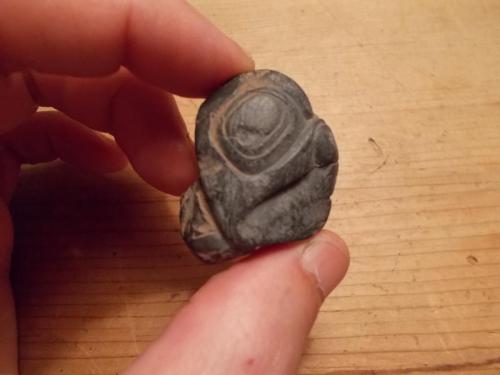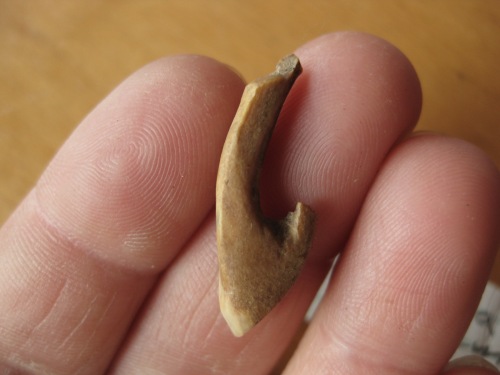
Dixon’s 1787 map showing Haida Gwaii as an Island. Source: Library of Congress
Old Maps are Cool. Enough said. Or maybe not quite enough. Continue reading

Dixon’s 1787 map showing Haida Gwaii as an Island. Source: Library of Congress
Old Maps are Cool. Enough said. Or maybe not quite enough. Continue reading
Posted in archives, First Nations, Haida Gwaii, history, Northwest Coast
Tagged Captain Dixon, cartography, charts, Haida Gwaii, Haida Nation, maps

Tom Beasley with Spanish olive jar from seafloor near Langara Island. Source: Northword Magazine.
One great thing about not keeping up with a blog is so much stuff accumulates like lint in the internavel that it is easy pickings to get material to post . . . . for example, the not very well known discovery by a fisherman of a Spanish colonial olive jar fragment in the waters off northern Haida Gwaii. There is a nice summary by Jane Stevenson of the find in a 2012 issue of Northword Magazine, and much more information in an open access 1992 article in BC Studies.
The latter article by Hector Williams et al. has some interesting tit-bits, such as that the jar has a nippled bottom. But I digress….. Continue reading
Posted in Archaeology, First Nations, Haida Gwaii, history, Northwest Coast, underwater archaeology
Tagged amphora, ceramics, Dadens, historical archaeology, jars, Kiusta, Spanish Americas

Autonomous Underwater Vehicle on surface of Juan Perez Sound, Haida Gwaii, with Parks Canada support vessel behind.
With sea levels rising by at least 120m globally at the end of the last ice age, conventional archaeological wisdom has been that sites on ancient coastlines are now deeply drowned. As is so often the case, conventional wisdom is over-simplified. The B.C. coast is a good example, since the effect of ice weighting in some places counterbalanced the lower sea levels, meaning significant chunks of the coastal plain and paleo-coastlines were never-drowned. Nonetheless, the underwater environment off the west coast doubtless contains thousands of early-period archaeological sites. Looking on land is more convenient, easier, cheaper, and allows one to breathe air – all good things. But looking underwater has some attractions too: methodological challenges, modelling issues, thinking about human life on a shrinking landmass, and a ridiculous amount of media coverage. The last is particularly important to University Administrators. Anyway, this month’s ASBC Victoria talk (poster, PDF) is on a project from a couple of years back which focused on attempting to find a particular kind of archaeological site on the sea floor: drowned fish weirs, especially rock wall ones, starting from the premise that such sites, which are often substantial in size, should be confined to stream channels and might be directly visible to sidescan sonar. For more information on the talk, click below.

NW Coast stone carving found in Chumash Territory, California. Source: http://www.arrowheadology.com/forums/showthread.php?t=42646&p=359269&viewfull=1#post359269
If someone out there in webland makes a link to my blog, and then someone else clicks on that link, I might be able to tell which site is referring to me. Sometimes this leads to unexpected discoveries. One of these incoming links is a query to an artifact collecting forum (boo) from a collector in southern California, who found the above small sculpture in Chumash territory. As is so common in the collector world, there is no other contextual information about this piece, which to my eye, appears to be an early historic Haida carving in argillite. Knowledgeable readers may wish to weigh in below in the comments section about the motifs and provenance of this sculpture – there are more fairly low-quality pictures here. How it made its way to the Santa Barbara area is anyone’s guess, it may have been a simple curio bought by a tourist, or it may be a now-lost bit of evocative human history like the one I suggested here for Haida argillite found on San Juan Island.

NW Coast stone carving found in Chumash Territory, California. Source: http://www.arrowheadology.com/forums/showthread.php?t=42646&p=359269&viewfull=1#post359269
Posted in Archaeology, California, Cultural Resource Management, Haida Gwaii, history, Northwest Coast
Tagged Archaeology, argillite, art, british columbia, California, Chumash, collecting, Haida, Haida Gwaii, pothunting, sculpture
The Victoria Chapter of the Archaeological Society of BC (ASBC) has a long-running monthly Fall-Spring speaker series which is starting again next week. The speaker is UVic Anthropology graduate student Jenny Cohen, speaking on results from her paleobotanical analysis of the 10,700 year old intertidal wet site, Kilgii Gwaay, in southern Haida Gwaii. It’s a fascinating site which gives real insight into the way of life of Ancestral Haida at the Pleistocene-Holocene transition and I’m sure Jenny’s thesis, nearing completion, will be of wide interest.
If you don’t have enough Kilgii Gwaay in your life then I recommend you jump over to the Burnt Embers blog, where there are some excellent photos from the tricky intertidal excavations at that site a few years ago: Setting Up; Keeping Water Out; Putting Water In; Water Screening; and Kilgii Gwaay Finds.
Abstract: Continue reading

Unusual fish hook fashioned from a canine tooth. Ca. 3000 years old, Burnaby Narrows, Haida Gwaii, 2012. Photo by Jenny Cohen.
Quick note to say there are two forthcoming public talks that might be of interest to residents of Vancouver or Victoria. The Vancouver one is by Dr. Ken Ames, Professor Emeritus at Portland State University, speaking at UBC on Thursday October 18th at 11.30. The Victoria one is by yours truly, speaking to the Archaeological Society of BC on Tuesday October 16th at 7.30. Details are below. Continue reading
Posted in Archaeology, First Nations, Haida Gwaii, Northwest Coast, Oregon
Tagged ASBC, Haida Gwaii, Ken Ames, Kilgii Gwaay, ubc
So I’ve never posted job ads here before and I may never do so again, but there are two ones posted right now with a lot of potential for readers of this blog: one is an archaeological position with the Council of the Haida Nation (PDF), the other a tenure track position in archaeological sciences at Washington State University.
Posted in Archaeology, Cultural Resource Management, First Nations, Haida Gwaii, Northwest Interior, Northwest Coast, Teaching, Uncategorized, Washington State
Tagged Archaeology, CHN, Council of the Haida Nation, CRM, Cultural Resource Management, Haida Gwaii, jobs, Washington State University, WSU
E. James (Jim) Dixon, now at the University of New Mexico, is pretty well known on the Northwest Coast for his pioneering work at the 10 to 12,000 year old 49-PET-408 (“On Your Knees Cave”) in the Alaskan Panhandle, and more recently for his exciting work on Alaskan Ice Patches. I see now that he apparently received some funding to go underwater during the summer of 2010 in the waters around PET-408, not far north from the aptly named Dixon Entrance, in Southeast Alaska (map). This work could have implications for the coastal route of First Peopling of the Americas.
I got contacted the other day by someone who was handling the estate of an elderly art collector. The entire collection is African with one exception, the panel pipe shown above, and with more pictures below. The person is looking for some basic information about these pipes and I suppose they will be charged with its disposition. They contacted me thinking I might know something about them because I have posted about such pipes before, but of course I am just an archaeologist and make posts about a lot of things of which I am largely ignorant.
I’ve given them contact information for someone who actually does know but in the meantime they said it would be ok to post these pictures here and see what the readers have to say.
Posted in First Nations, Haida Gwaii, Miscellaneous

Raven and the First People (Bill Reid), and Raven and the First Immigrant (Nicholas Galanin). Source: Nicholas Galanin, http://silverjackson.tumblr.com/
I’m a big fan of classic Northwest Coast art – it’s hard not to be. But there is also a large and highly talented array of indigenous Northwest Coast artists who work in a variety of media and contemporary idioms. One who recently caught my eye is Sitka Tlingit artist Nicholas Galanin. You probably recognize the figure in the foreground above: Bill Reid’s iconic “Raven and the First People” (if not from class, then from your 20$ bill), which tells the story of Raven-Travelling in ancient times, finding a clamshell, hearing noises inside, and releasing people and animals into a transforming world.
But wait, what’s that figure in the background, on the other side of the glass window, in the courtyard of the MOA?
Posted in alaska, First Nations, Haida Gwaii, Northwest Coast
Tagged art, Bill Reid, Haida Art, MOA, Museum of Anthropology, museums, Nicholas Galanin, sculpture, Sitka, tlingit, Tlingit Art